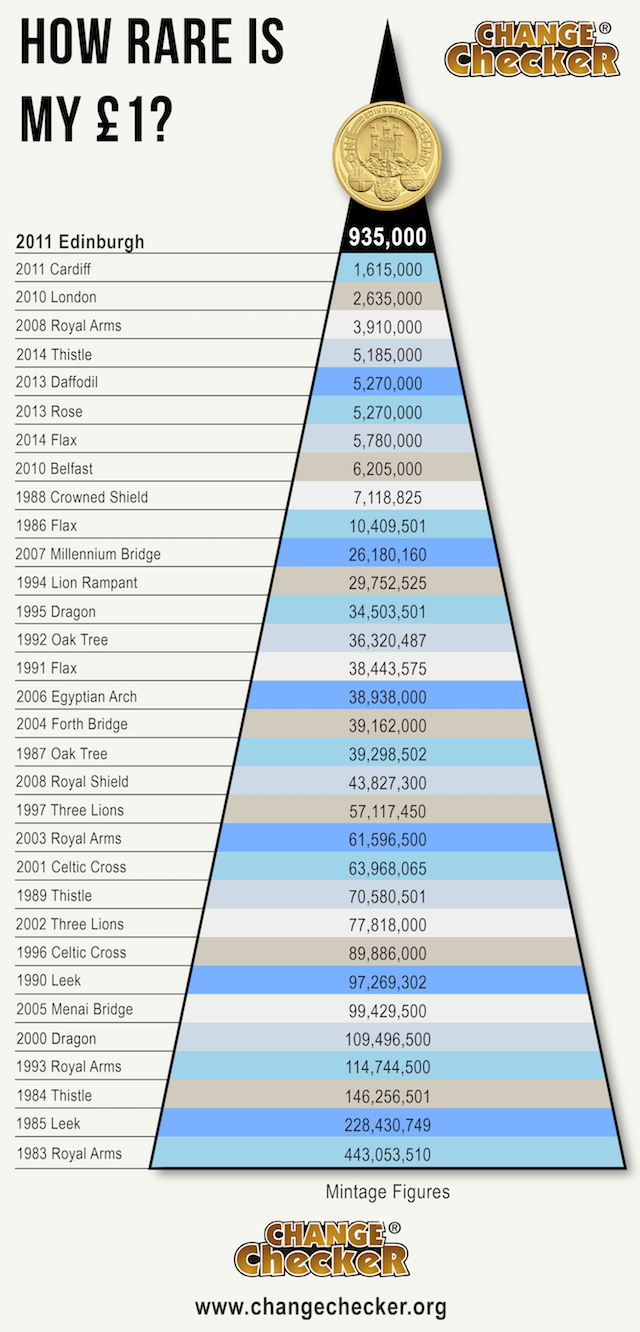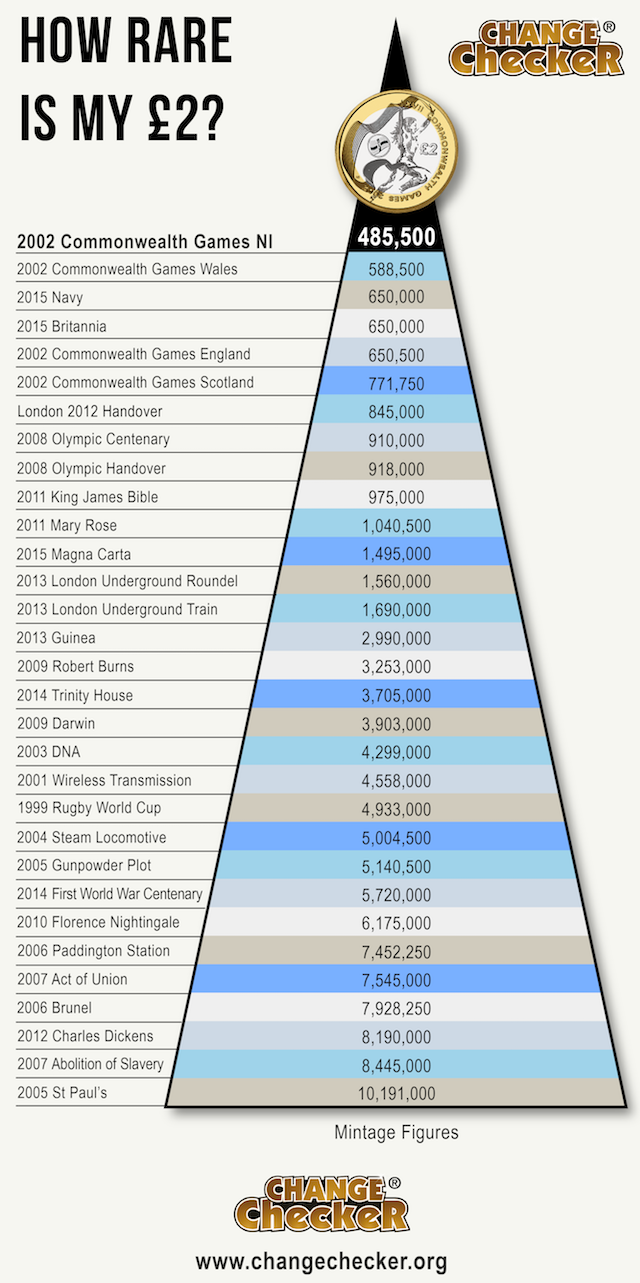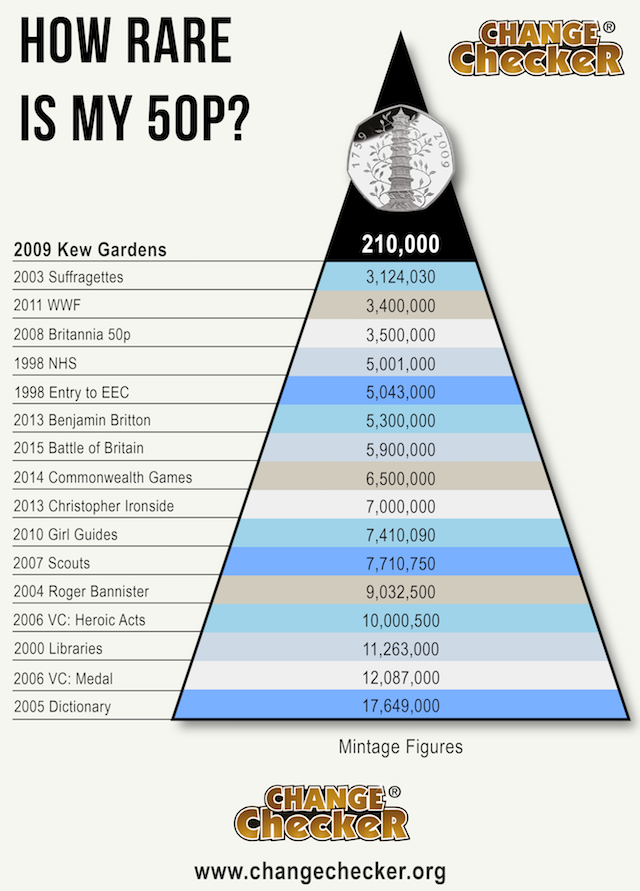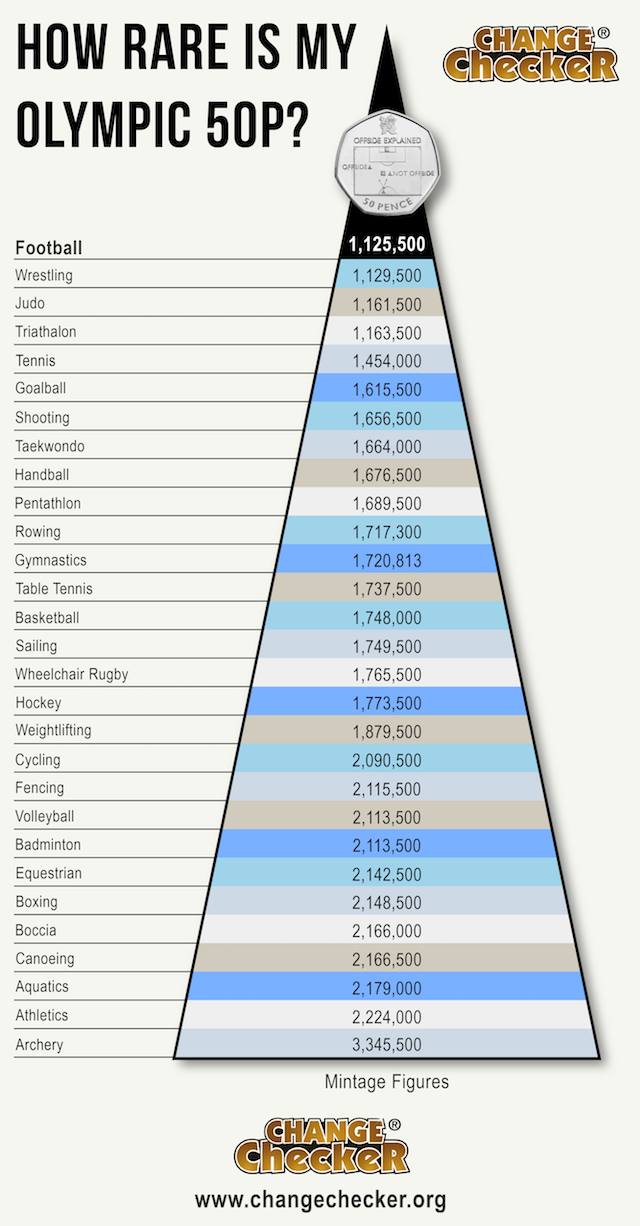Coin Info
How rare is my coin? The Complete Change Checker Guide to UK Coin mintages
Have I just found a rare coin? It’s a question which collectors ask daily, and to help answer it, we’ve put together these charts listing each coin in order of its rarity.
The Northern Ireland 2002 Commonwealth Games is the rarest £2 coin currently in circulation – in fact the four designs in the 2002 Commonwealth Games series occupy the top ten list. There were only 485,500 Northern Ireland 2002 Commonwealth Games £2 coins minted, that’s just 0.1% of all the £2 coins ever struck!
Others to look out for include the 2015 Navy £2 and the 2015 Britannia £2, both coins have recently been issued into circulation and share joint third place on our graph.

Themes have followed a similar pattern over the years with the four constituent countries of the United Kingdom being represented in cycles. The rarest One Pound coin currently in circulation is the Edinburgh £1 which was part of the series depicting the capital cities of the UK.
The Edinburgh design is the only £1 coin with a mintage below 1 million and by way of comparison, over 443 million Royal Arms shield £1 coins were issued in 1983. The 2011 Cardiff £1 and the 2010 London £1 follow closely behind, so all very sought after £1 coins to have.
Another coin to look out for is The Royal Arms £1. Although this is a common design which is regularly ignored, make sure to look out for one with a 2008 date – that’s actually the fourth rarest £1 coin.
The rarest coin in circulation, of any denomination, is the Kew Gardens 50p. the Kew Gardens 50p has been valued at up to £50 on online market place eBay. Its status as the most scarce coin has been well publicised, and as a result, many are hoarded by collectors. This chart illustrates just how rare it is compared with other Fifty Pence designs.
The Olympic Fifty Pence series is very popular with Change Checkers, but in terms of rarity, there really isn’t much separating the top 10 designs. The Football ‘Offside Rule’ 50p was certainly one of the most talked about designs, and it also narrowly ranks as the scarcest.
So, keep hold of your coins. You never know what they might be worth in the future! And remember you can Find, Collect and Swap all your coins for FREE with the Change Checker App: www.changechecker.org
Are these the most sophisticated fake £2 coins?
£2 coins were introduced in 1998 to prevent against counterfeiting and were the first bi-metallic coins to enter circulation in the UK.

£2 coins were first issued into circulation in 1998
Made with two different metal components, £2 coins are very complicated to manufacture and very difficult to counterfeit… or so we believed.
As we know, 1 in 30 £1 coins are fake. The Royal Mint are so concerned, they’ll be introducing a new 12-sided £1 coin in March which is billed to become the most secure circulating coin in the world.
But, this means that counterfeiters are now turning their attention to the £2 coin.
To begin with, early £2 counterfeit coins were just a lump of led tin alloy, spray painted to look like a genuine £2 coin and were easy to tell apart from the real thing.
Now, they’re becoming a lot harder to spot, even by professionals. Some fake £2 coins are even being accepted in vending machines and car parking machines.
So how many fakes are out there and who’s responsible?
Fraudsters require a highly sophisticated press to produce bi-colour coins. It’s thought that there are hundreds of thousands of fake £2 coins in circulation and is definitely a form of organised crime.
Can you spot one?
There are a few simple ways to tell if you have a fake £2 coin. One of the most obvious ways to spot a fake is by comparing the quality of the writing on the edge inscription to a genuine coin and also checking that the edge inscription matches the design.
However there are still some fake £2 coins that pass the two tests above.
According to experts, fakes can usually be detected by the weight. Genuine £2 coins should weigh 12g, but these remarkable new counterfeit £2 coins are also weighing in at 12g.
Each UK denomination is made up of different compositions which are agreed between The Royal Mint and HM Treasury but the exact amount is kept top secret.
The only way to find out for definite if the coin is real or fake is for it to be x-rayed by a special machine which gives a reading of all the different elements that have gone into the coin.
So should we be increasing the security of the £2 coins to make it harder for them to be counterfeited?
Let us know your thoughts via Facebook, Twitter or leave us a comment below.
Is it time to scrap the Penny?
Pennies have been around in Britain for over a thousand years, but is it now time for the penny to be dropped?
Mark Carney, Bank of England Governor, thinks it is inevitable that Britain will follow countries such as Canada, New Zealand and Australia and scrap the penny.
As Governor of the Bank of Canada he oversaw the withdrawal of the 1p coin equivalent and claims the process was really successful among Canadians.
Not only was the 1 cent coin unmissed by Canadians and reduced the cost of transactions for both businesses and the Government, a massive $11m was saved in the first year by discontinuing the production of the coins.
But are we ready to say farewell to the British Penny?

The Penny has been around for over 1,200 years.
The Penny was one of the earliest British coins, first minted in the 8th century AD.
The silver penny became universal throughout Britain in 959 and until the reign of Henry III in 1234 it was one of the only denominations minted.
The Penny even survived decimalisation in 1971 making it one of the only denominations that was kept during the changeover.
Although it’s fair to say that pennies are rarely used to buy anything, it’s thought that an estimated 11.2 billion pennies are currently in circulation.
What about Ireland’s ‘Rounding’ Initiative?
In October 2015, Ireland lauched its ‘Rounding’ initiative. It aimed to reduce the use of 1 cent and 2 cent coins by rounding the total amount of any bill paid by cash on a voluntary basis up or down to the nearest 5 cent mark.
So far, 126 million coins have been taken out of circulation. So could Britain follow in the same footsteps as Ireland?
As with any coin, the loss of the penny would be a blow to coin collectors everywhere. But we must remember that these changes are part of what makes coin collecting so interesting. Designs change, new coins come into existence and some coins will inevitably disappear.
So should we get rid of the Penny? Let us know in our poll:



